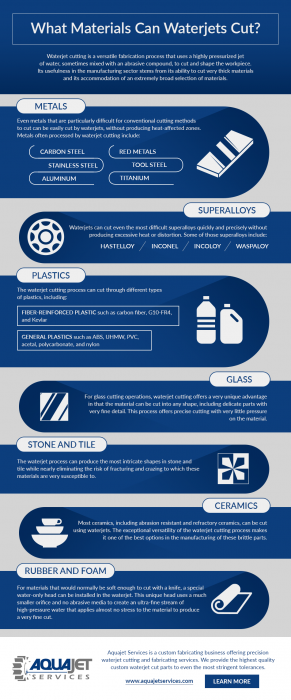Waterjet cutting is a versatile fabrication process that uses a highly pressurized jet of water, sometimes mixed with an abrasive compound, to cut and shape the workpiece. Its usefulness in the manufacturing sector stems from its ability to cut very thick materials and its accommodation of an extremely broad selection of materials, including the following:
- Metal
- Plastic
- Composites
- Ceramic
- Rubber
- Glass
- Stone
- Tile
Waterjets can accommodate thicknesses that are unachievable with nearly any other cutting method, from the thinnest shim stock, all the way up to massive plates with thicknesses of 12 inches (and greater!) The waterjet process also eliminates the need for secondary processing to create highly accurate parts.
Materials Accommodated by the Waterjet Cutting Process
 Some of the typical materials which can be cut by the waterjet cutting process include:
Some of the typical materials which can be cut by the waterjet cutting process include:
Metals
When used for cutting metals, waterjet cutting offers several benefits. Unlike traditional cutting methods, in waterjet cutting, the cutting area experiences very little heat or friction, allowing parts to be processed without changing the properties of the material or introducing stress. Even metals that are particularly difficult for conventional cutters due to their exceptional hardness, such as hardened tool steel, can be easily cut by waterjets, without producing heat-affected zones.
Metals often processed by waterjet cutting include:
- Carbon steel
- Stainless steel
- Aluminum
- Red Metals (Copper, Brass and Bronze)
- Tool Steel (annealed or hardened)
- Titanium
Superalloys
Difficult-to-cut special superalloys—such as Hastelloy, Inconel, Incoloy and Waspaloy—are particularly challenging for traditional cutting methods, as they tend to be too hard or tough to cut cleanly and cause undue wear on cutting tools. Waterjets, however, can cut even the most difficult superalloys quickly and precisely without producing excessive heat or distortion.
Plastics
Similarly to how it handles metals, the waterjet cutting process offers several benefits for plastic cutting operations. For example:
- For fiber-reinforced plastics—such as carbon fiber, G10-FR4, and Kevlar—the process reduces the risk of delamination, resin burn, and fiber fraying which are very difficult to overcome with traditional machining methods.
- For general plastics—such as ABS, UHMW, PVC, acetal, polycarbonate, and nylon—the waterjet cutting process is preferred because of its ability to cut quickly without producing fumes or dust. Also, most plastics have a high coefficient of thermal expansion, making them dimensionally unstable when subjected to friction and heat. Since waterjets transfer virtually no heat to the workpiece, they can produce very accurate plastic parts.
Glass
For glass cutting operations, waterjet cutting offers a very unique advantage in that the material can be cut into any shape, including delicate parts with very fine detail. Whereas traditional cutting methods might cause glass to break due to the pressure applied by the cutting tool, waterjet cutting offers precise cutting with very little pressure on the material. Even multi-layered panels like laminated glass and bullet-proof glass can be easily and quickly cut with a waterjet.
Stone and Tile
The waterjet cutting process is suitable for the precision cutting of any stone material. As with glass, conventional cutting methods are very limited in their ability to cut stone into anything but simple shapes. The waterjet process can produce the most intricate shapes in stone and nearly eliminates the risk of fracturing and crazing to which stone and tile are very susceptible. Typical applications involving these materials include the cutting of tiles for floor medallions as well as cutting large slabs of stone for countertops or architectural panels.
Ceramics
Most ceramics, including abrasion resistant and refractory ceramics, can be cut using waterjets. Similar to glass and stone, ceramics can be very brittle. Some types of ceramics can be significantly harder than steel, making them one of the most difficult materials to cut. The exceptional versatility of the waterjet cutting process makes it one of the best options in the manufacturing of ceramic parts.
Rubber and Foam
Waterjet cutting is an ideal method for the production of many rubber and foam parts. For materials that would normally be soft enough to cut with a knife, a special water-only head can be installed. This unique head uses a much smaller orifice and no abrasive media to create an ultra-fine stream of high-pressure water that applies almost no stress to the material to produce a very fine cut.
Versatile Waterjet Cutting Services From Aquajet
Aquajet Services is a custom fabricating business offering precision waterjet cutting and fabricating services. We provide the highest quality custom waterjet cut parts to even the most stringent tolerances. Regardless of the complexity of your project, our team is ready to take it on and overcome the challenge. By maintaining a large stock of materials in a variety of sizes, streamlining production operations, and employing tracking methods, we are able to deliver your products with a faster turnaround.
For more information on our waterjet cutting services, contact us today.

